Dark UI Patterns in Government Advertising
In recent years, the use of dark UI (user interface) patterns has become increasingly common in digital advertising. These design techniques are intended to manipulate users into taking certain actions, often without their full knowledge or consent. While the use of these patterns is controversial in any context, it is especially concerning when they are employed in government advertising.
Dark UI patterns are often used in marketing to influence user behavior in a way that benefits the company. Some common examples of dark patterns include things like "sneak into basket" (where a product is added to a user's shopping cart without their explicit consent), "roach motel" (where it is difficult to unsubscribe or cancel a service), and "misdirection" (where a user is led to take an unintended action).
When it comes to government advertising, the use of dark patterns can be particularly insidious. Governments have a responsibility to act in the best interests of their citizens, and this includes being transparent and honest in their communications. However, when they employ manipulative design techniques to push a particular agenda or policy, it undermines the trust that citizens have in their government.
One example of the use of dark UI patterns in government advertising is the way that certain political campaigns use persuasive design to solicit donations. They may use techniques such as "forced action" (where a user is automatically enrolled in a recurring donation program), "framing" (where a donation amount is presented in a way that makes it seem smaller than it is), or "pre-selection" (where a user is presented with a default option that is already selected for them).
These techniques are often used in a way that is misleading or coercive, and they can have serious consequences for individuals and society as a whole. For example, if a political campaign were to use dark patterns to collect large amounts of money from unwitting supporters, it could have a significant impact on the outcome of an election. This would be a clear violation of the principles of fair and democratic elections.
In order to address the use of dark UI patterns in government advertising, it is important for both designers and policymakers to be aware of their impact. Designers should prioritize ethical design practices, and policymakers should work to ensure that advertising regulations are updated to include digital channels. Citizens can also play a role by being aware of these patterns and reporting any instances where they believe they have been misled or coerced.
Ultimately, the use of dark UI patterns in government advertising is a threat to the democratic process and the trust that citizens have in their government. It is important for all stakeholders to take action to ensure that these techniques are not used in ways that are harmful or deceptive.
Reviews
“Tricking Users — Dark Patterns in UI Design” by Pete Gray is an insightful e-book that delves into the world of unethical design techniques employed by companies to manipulate and deceive users online. Let’s explore the key points:
Concept of Dark Patterns:
The book begins by explaining what dark patterns are. These are intentionally designed techniques that trick users into making decisions that are not in their best interest. Examples include signing up for unwanted services or purchasing unnecessary items.
Specific Examples:
Gray discusses various dark patterns found on websites and apps:
Misleading Language: Companies use vague or deceptive wording to confuse users.
Hidden Fees: Concealing additional charges until the last moment.
Misleading Buttons: Designing buttons that lead users to unintended actions.
Consequences:
The use of dark patterns erodes user trust and can even lead to legal repercussions.
Understanding these consequences is crucial for designers and businesses.
User Protection and Ethical Design:
The e-book provides tips for users to shield themselves from manipulative tactics.
Designers are encouraged to avoid using dark patterns in their work.
In summary, “Tricking Users — Dark Patterns in UI Design” sheds light on the shadowy side of user experience and emphasizes the importance of ethical design practices. Gray’s concise exploration serves as a valuable resource for both designers and users.
